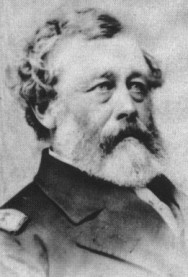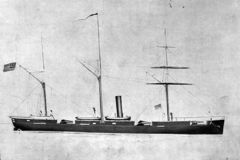

Then-Commander James H. Strong, USN, as commanding officer of USS Monongahela, March 1864.
In April 1861, Strong was promoted to the rank of commander, and commanded USS Mohawk and Flag in the South Atlantic Blockading Squadron in 1861–62. On the night of 8 May 1862, Flag captured the schooner Amelia, which had sailed from Charleston with cargo of cotton and was attempting to run the Union blockade. During a storm a week later, while under tow, Amelia developed a serious leak and had to be abandoned.
In 1863, Strong assumed command of the new wooden screw sloop-of-war Monongahela in the West Gulf Blockading Squadron under Rear Admiral David Farragut. By the summer of 1864, the squadron had sealed off all Confederate ports except one, Mobile Bay, Alabama.
In entering the bay, Farragut foresaw his warships would be confined to a narrow, mined channel close under Fort Morgan’s guns and then face his old friend Admiral Franklin Buchanan’s CSS Tennessee, the most powerful Confederate ironclad of the war. In the event, the lead ships faltered, leaving the admiral to order his flagship Hartford first through the minefield (“damn the torpedoes”) and meet Tennessee, which was prepared to fight to the end.

USS Monongahela as she appeared during the Civil War.
At first, neither side gained an advantage in the mêlée that followed. Then, ignoring all the other Union vessels, Tennessee steered to ram Hartford. But Commander Strong had foreseen this maneuver and, with a full head of steam, drove Monongahela into Tennessee. The collision knocked off Monongahela’s own iron-protected cutwater and she suffered from Tennessee’s guns as the two ships slid past one another. Other Union ships followed Strong’s example, however, and after 90 more minutes of action, Buchanan surrendered.
Commander Strong received high commendation for his initiative and valor during this action, the last great naval battle of the Civil War, and was promoted captain. Thereafter, he served at New York Navy Yard (1866–67) and commanded sloop-of-war Canandaigua in the Mediterranean Squadron (1869–70).
In September 1873, he was promoted rear admiral and served as commander-in-chief of the South Atlantic Squadron from 1873–75, retiring 25 April 25, 1876. He died in Columbia, South Carolina 28 November 1882.